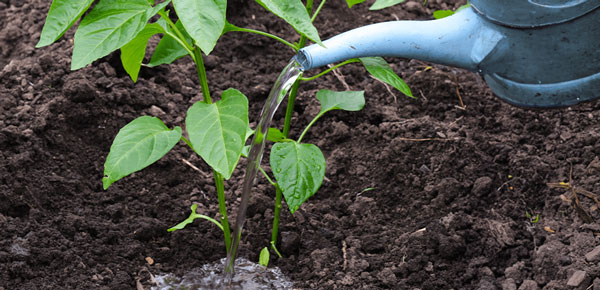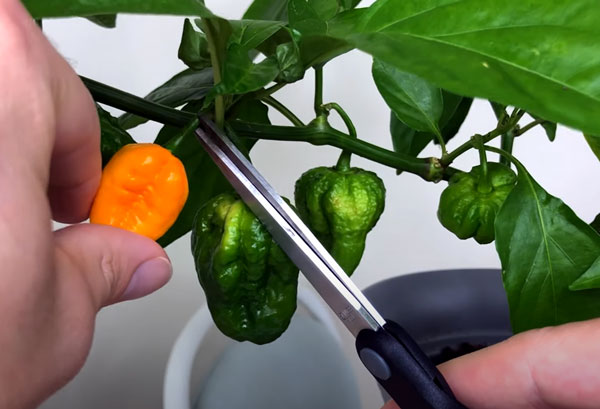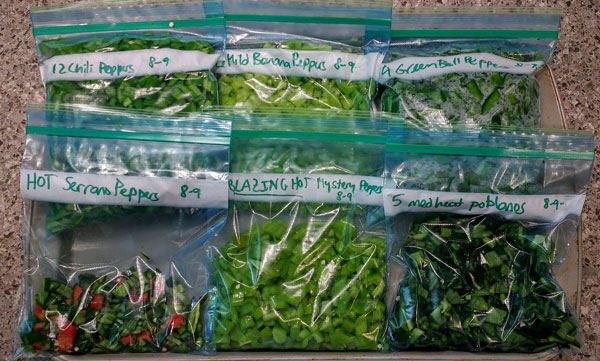Growing peppers in your home garden can be a rewarding and flavorful experience. With their adaptability to various climates and a wide array of varieties, peppers are an ideal choice for both beginner and experienced gardeners. In this comprehensive guide, we'll explore the best practices for cultivating peppers, maximizing yield, and preserving your bountiful harvest.

Quick Reference to Contents
- Choosing the Right Variety
- Understanding Pepper Plant Growth
- Location and Soil Health
- Managing Sun Exposure
- Watering Peppers
- Fertilizing Peppers
- Pruning
- Harvesting Techniques
- A Second Harvest
- Supporting Your Plants
- Cross-Pollination: A Note for Seed Savers
- Battling Pests and Diseases in Pepper Plants
- Preserving Your Pepper Harvest
- Pepper Companion Plants
Choosing the Right Variety
Peppers come in a plethora of varieties, each with its unique flavor, color, and heat level. From sweet bell peppers to fiery hot chilis, there's a variety to suit every palate. Additionally, many pepper varieties currently available boast disease resistance and quick fruiting, with short days to maturity, making them a practical choice for gardeners looking to enjoy a speedy harvest or for those gardeners in areas with a short growing season.
Understanding Pepper Plant Growth
Contrary to common belief, pepper plants can be grown as a perennial in frost-free environments, meaning that with proper care your pepper plants can last for many years. If growing as a perennial, a consistent fertilization schedule will ensure the best quality and productivity, as growing your plants in the same spot will deplete certain nutrients. This perennial growth potential is especially beneficial for those looking to have a long-term investment in their garden.
Location and Soil Health
Selecting an ideal location for your pepper plants is crucial. These plants thrive in well-draining soil and require ample sunlight. Ensure your peppers are planted in a spot that receives at least 6 hours of direct sunlight daily. Also, enriching your soil with compost or other organic matter can significantly impact the health and, ultimately, the yield of your pepper plants.
Managing Sun Exposure
Protect your pepper plants from excessive sun, which can cause sun scald. Planting in dense arrangements, planting other taller vegetables on their sun-facing side, or using shade cloth during the hottest parts of the day can protect your peppers. This is more crucial for southern gardens.

Watering Peppers
General Watering Guidelines
Stress Technique: Let the top inch of soil dry out before watering to prevent overwatering.
Watering Frequency:
- In the Garden: Once per week.
- In Pots: 2-3 times per week, depending on weather and pot size.
Signs of Overwatering and Underwatering:
- Underwatering: Wilting leaves.
- Overwatering: Yellowing leaves, lack of new growth, and wilting, despite wet soil.
Watering Techniques:
Base Focus: Water at the base of the plant to avoid wetting the foliage, which helps to prevent fungal diseases.
Consistent Moisture: This is especially important during the fruiting stage. Allow the top of the soil to dry before watering again.
Correcting Overwatering: Stop watering and let the top 2 inches of soil dry out if your pepper plants show symptoms of overwatering.
Remember: Proper watering is crucial for healthy growth and abundant harvests when it comes to pepper plants. Keep a close eye on your plants' leaves for any signs of distress.
Fertilizing Peppers
Recommended Fertilizer: Use a fertilizer with an N-P-K (Nitrogen-Phosphorus-Potassium) ratio of either 5-10-10 or 10-20-20, ideal for better root health and for producing more fruit. If you want a foil-proof application, we recommend Espoma's Tomato-tone for the perfect pepper fertilizer!
Application Schedule:
- Initial Application: When transplanting your pepper plants.
- Subsequent Applications: Every 3-4 weeks thereafter.
Organic Options: Consider compost, bone meal, Neptune’s Fish and Seaweed, or Worm Castings for organic fertilization and soil health improvement. Use according to the package directions.
Pruning
Recent studies have shown that pruning does not necessarily enhance yield or quality. In fact, unpruned pepper plants often produce larger and heavier fruits. By skipping the pruning process, you will save time and potentially achieve a more abundant harvest.
Harvesting Techniques

Harvesting peppers promptly and correctly is key to the ongoing health of the plant. Use small sharp shears or scissors to detach the peppers, especially for types that don’t easily come off. This practice helps avoid damage to the plant and will save injury to your fingers. Regular harvesting also encourages your pepper plants to produce more fruit.
A Second Harvest:
Pepper plants possess a remarkable capacity for multiple flowering and fruiting cycles in one growing season, a trait often overlooked by home gardeners. This ability stems from their natural growth cycle. After the initial fruits are harvested, the plant instinctively gears up for another flowering and fruiting phase. This reflowering is facilitated by redistributing energy from the mature fruits to new flowers and fruits.
Factors like season length, temperature, and light also play a role. In areas with longer warm weather seasons, multiple flowering and fruiting cycles are more likely. Peppers thrive in warm, sunny conditions; however, as days shorten and temperatures drop, their reflowering capability may diminish.
Fertilizing pepper plants immediately after the main harvesting is completed is essential to replenish the nutrients your pepper plants have exhausted during heavy fruit production. This process aids in your plants’ recovery and prepares them for the next production cycle. Again, we recommend a fertilizer with an NPK of 5-10-10 or 10-20-20. Worm Castings are also beneficial for a successful second harvest.
Supporting Your Plants:
For varieties that produce heavy fruits or in gardens exposed to strong winds, supporting your plants may be necessary. Use stakes or cages to prevent your pepper plant stems from breaking or bending, which may result in the fruit touching the ground. A simple bamboo stake with twine will usually provide sufficient support.
Cross-Pollination: A Note for Seed Savers:
If you plan to save seeds, be mindful of cross-pollination. While it probably won’t affect the flavor of this year’s crop, it could result in hybrid seeds, leading to unexpected varieties in the next planting season. This is especially relevant if you’re growing both sweet and hot pepper varieties together. To ensure that cross-pollination does not occur, the experts recommend you plant your hot and sweet varieties at least 500 feet apart. Alternatively, you can cover your pepper plants with a barrier to prevent pollinators from alighting on them, use small plastic bags to cover the blossoms, or utilize tents to cover your pepper plants while allowing for adequate air circulation.
Battling Pests and Diseases in Pepper Plants:
The Most Common Pests and Their Management
- Aphids: These small, sap-sucking insects can quickly become a nuisance. They often cluster on young shoots and reside on the undersides of leaves, causing yellowing and distorted growth.
- Control: Use insecticidal soaps or neem oil. Encourage natural predators like ladybugs and lacewings.
- Spider Mites: Tiny and destructive, spider mites create fine webs on pepper plants. They cause spotted and yellowing leaves.
- Control: Regularly rinse plants with water to dislodge mites, being sure to catch the undersides of the leaves. Use miticides or neem oil for severe infestations.
- Cutworms: These caterpillars feed at night, cutting through young pepper stems at the soil line.
- Control: Keep the garden free of weeds and debris. Use collars around the bases of the stems of young plants. Biological pesticides like Bacillus thuringiensis can also be effective.
- Companion Plants: This organic method can be quite effective. Growing dill and sweet alyssum close to your pepper plants will attract beneficial insects to get rid of any damaging pests.
The Most Common Diseases and Treatment
- Bacterial Spot: This disease causes small, dark spots on leaves and fruit, often with a yellow halo around the spots.
- Prevention and Treatment: Use disease-free and resistant seed varieties. Apply copper-based fungicides at the first sign of disease.
- Powdery Mildew: This fungus appears as white, powdery spots on leaves and stems. It thrives in both dry and humid weather.
- Treatment: Improve air circulation around your pepper plants. Use sulfur or potassium bicarbonate-based fungicides.
- Root Rot: Caused by overwatering and/or poor drainage, root rot leads to wilting and yellowing of the leaves on your pepper plants.
- Prevention: Ensure good drainage in pots and garden beds. Water only when the top inch of the soil is dry.
Preventive Measures for a Healthy Pepper Garden
- Regular Inspection: Early detection is key. Inspect your pepper plants regularly for any signs of pests or disease.
- Good Hygiene: Keep your garden plot clean. Remove and destroy infected or infested plant parts.
- Crop Rotation: Don’t plant peppers in the same spot year after year. This practice helps reduce disease buildup in the soil.
Preserving Your Pepper Harvest:

Storing Fresh Peppers
- Short-Term Storage: Fresh peppers can be stored in the refrigerator for up to a week. Place them in a plastic bag in the vegetable crisper drawer to maintain freshness.
- Room Temperature Storage: For peppers you plan to use within a few days, storing them at room temperature on the counter will keep them ripe and flavorful.
Drying Peppers
- Air Drying: This method is best for thin-walled peppers, which includes many of the hot pepper varieties, such as: Anaheim, Banana, and Shishito peppers. String them up in a dry, well-ventilated area away from direct sunlight. It can take several weeks for peppers to dry completely.
- Oven Drying: For faster results, cut peppers into halves or quarters, removing the seeds and membranes. (If drying hot peppers, we recommend using gloves during the preparation process.) Place on a baking sheet lined with parchment paper and dry in an oven set to the lowest possible temperature. Check regularly to avoid scorching.
- Dehydrator: This is a very efficient drying method. Follow your dehydrator's instructions for temperature and time settings.
Storing Dried Peppers
- Dried peppers can be stored in airtight containers, in your pantry, for several months. They can be used in a variety of dishes. You can also rehydrate them by soaking them in water.
- Dried peppers can be frozen. Use a plastic freezer bag and squeeze as much of the air out as possible. We don’t recommend using the straw method to remove the air; inhaling the heat from the peppers will not be pleasant.
Pickling Peppers
- Ingredients: You'll need vinegar, water, sugar, salt, and desired spices (like garlic, dill, or mustard seeds).
- Preparation: Wash peppers, then slice, dice, or leave whole (pierce whole peppers to allow brine to penetrate).
- Brine: Bring your vinegar, water, sugar, and salt mixture to a boil. Add spices as desired.
- Pickling: Place peppers in sterilized jars and pour the hot brine over them. Seal the jars and process them in a water bath canner for long-term storage, or simply refrigerate and consume them within a few weeks.
Freezing Peppers
Frozen peppers are excellent for cooked dishes like stir-fries, soups, and stews.
- Preparation: Wash and dry peppers. Remove the stems, seeds, and membranes. You can freeze them whole, sliced, or diced.
- Blanching (Optional): For better texture, blanch peppers in boiling water for a few minutes, then plunge into ice water before thoroughly drying and freezing.
- Freezing: Spread peppers in a single layer on a baking sheet to freeze individually. Once frozen, transfer them to freezer bags or containers.
Tips for Maximum Flavor and Preservation
- Label and Date: Always label your preserved peppers with the date and variety. This helps you keep track of freshness, ensuring you use the oldest stock first. Once frozen, the types of peppers may be hard to identify. Be sure to include the heat level: hot, medium, or mild, as appropriate.
- Quality Matters: Only preserve peppers that are in good condition. Discard any with signs of rot or blemishes.
- Variety Exploration: Experiment with different varieties of peppers. Each type brings a unique flavor and heat level to your dishes.
Preserving peppers is not only practical, but also a delightful way to enjoy your garden’s bounty year-round. Whether drying, pickling, or freezing, these methods ensure you’ll always have delicious peppers at hand for your culinary creations!
Pepper Companion Plants
Companion planting is a fantastic strategy to boost the health, flavor, and yield of your pepper plants. By pairing peppers with certain plants, you can create a mutually beneficial environment that promotes natural pest control, improves soil health, and enhances overall garden productivity. Here are some excellent companion plants for peppers:
- Basil: Basil is a classic companion for peppers. It not only enhances the flavor of peppers but also helps repel common pests like aphids, spider mites, and mosquitoes. The aromatic oils in basil can deter harmful insects while attracting beneficial ones, such as bees, which are essential for pollination.
- Marigolds: Marigolds are known for their pest-repelling properties. Planting marigolds around your pepper plants can help keep nematodes, aphids, and beetles at bay. Additionally, marigolds attract predatory insects that feed on pepper pests, creating a more balanced and healthy garden ecosystem.
- Onions and Garlic: Onions and garlic are excellent companions for peppers as they help deter aphids, slugs, and other pests with their strong smell. Their shallow roots also allow them to grow close to peppers without competing for nutrients, making them ideal partners in a small garden space.
- Spinach and Lettuce: These leafy greens grow well in the shade of taller pepper plants. They provide ground cover, which helps retain soil moisture and suppress weeds. Growing spinach and lettuce alongside peppers can maximize your garden space and ensure that all available sunlight and nutrients are efficiently used.
- Carrots: Carrots can be planted near peppers without competing for space or nutrients. The roots of carrots help aerate the soil, improving drainage and promoting healthy root development for peppers. Additionally, carrots attract beneficial insects that can help control pepper pests.
- Tomatoes: Peppers and tomatoes are part of the same plant family (Solanaceae) and share similar growing conditions. They can be planted together to optimize space and resources. Both plants benefit from the same soil amendments and watering schedules, making them ideal companions in a well-organized garden.
- Nasturtiums: Nasturtiums are a beautiful and functional addition to any pepper garden. These flowers attract aphids away from pepper plants and act as a trap crop. Nasturtiums also attract predatory insects like ladybugs and lacewings, which help control pest populations naturally.
Tips for Successful Companion Planting
- Diversity: Mix different companion plants to create a diverse and resilient garden ecosystem.
- Spacing: Ensure proper spacing between plants to avoid overcrowding and competition for resources.
- Observation: Monitor your garden regularly to see how the companion plants are interacting and make adjustments as needed.
- Rotation: Practice crop rotation to prevent soil depletion and reduce the risk of diseases.
Incorporating these companion plants into your pepper garden can lead to healthier plants, increased yields, and a more enjoyable gardening experience. Experiment with different combinations to find what works best for your specific garden conditions.
Peppers are a versatile and rewarding addition to any home garden. By understanding their specific needs and providing the proper care, you will enjoy a bountiful and flavorful harvest. Remember, the key to success lies in choosing the right variety, providing adequate support, water management and fertilization, and understanding the nuances of harvesting and pruning.
Here are some additional resources that you might find helpful:
USDA Plant Hardiness Zone Map: https://planthardiness.ars.usda.gov/
National Gardening Association: https://garden.org/
Cornell University Cooperative Extension: https://cals.cornell.edu/about/newsroom/calsnews
































































































































































































































































































































































































































































































































































































































































